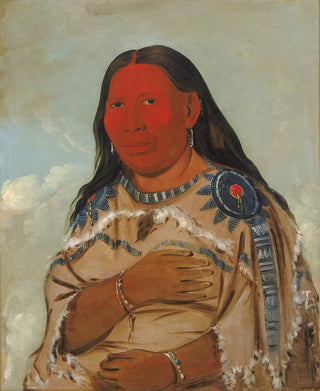Art print | Woman of Two Crows - George Catlin


View from behind

Frame (optional)
George Catlin's artwork "Woman of Two Crows" is an iconic piece that immerses viewers in a universe where nature and culture intersect. Created in the 19th century, it reflects the artist's commitment to documenting Indigenous peoples of North America through his unique perspective. As a passionate observer, Catlin captures the essence of his subjects with an emotional depth that still resonates today. The woman depicted, surrounded by crows, evokes a mystical connection with the animal world, and this image, both powerful and delicate, invites reflection on the harmony between humans and nature.
Style and uniqueness of the artwork
Catlin's style is distinguished by its ability to blend realism and symbolism. In "Woman of Two Crows," vibrant colors and meticulous details showcase his technical mastery. The composition is carefully orchestrated, with each element seemingly telling a story. The crows, symbols of wisdom and mystery in many cultures, add a spiritual dimension to the scene. The woman, meanwhile, is portrayed with palpable dignity, her features and clothing reflecting the cultural identity of Indigenous peoples. Catlin succeeds in establishing a dialogue between the characters and their environment, creating an immersive atmosphere that transports the viewer to the heart of ancestral traditions. This piece, through its aesthetic and message, stands out in art history as a tribute to the richness of Indigenous cultures.
The artist and his influence
George Catlin, born in 1796, is often regarded as one of the first artists to dedicate his career to representing Indigenous peoples. Traveling across the United States, he created numerous portraits and scenes of life, seeking to preserve the memory of these cultures in the face of colonial expansion. Catlin's influence is undeniable, not only in the field of art but also in how he contributed to a better understanding of Indigenous cultures. His empathetic and respectful approach paved the way for a new appreciation of cultural diversity.

Matte finish

View from behind

Frame (optional)
George Catlin's artwork "Woman of Two Crows" is an iconic piece that immerses viewers in a universe where nature and culture intersect. Created in the 19th century, it reflects the artist's commitment to documenting Indigenous peoples of North America through his unique perspective. As a passionate observer, Catlin captures the essence of his subjects with an emotional depth that still resonates today. The woman depicted, surrounded by crows, evokes a mystical connection with the animal world, and this image, both powerful and delicate, invites reflection on the harmony between humans and nature.
Style and uniqueness of the artwork
Catlin's style is distinguished by its ability to blend realism and symbolism. In "Woman of Two Crows," vibrant colors and meticulous details showcase his technical mastery. The composition is carefully orchestrated, with each element seemingly telling a story. The crows, symbols of wisdom and mystery in many cultures, add a spiritual dimension to the scene. The woman, meanwhile, is portrayed with palpable dignity, her features and clothing reflecting the cultural identity of Indigenous peoples. Catlin succeeds in establishing a dialogue between the characters and their environment, creating an immersive atmosphere that transports the viewer to the heart of ancestral traditions. This piece, through its aesthetic and message, stands out in art history as a tribute to the richness of Indigenous cultures.
The artist and his influence
George Catlin, born in 1796, is often regarded as one of the first artists to dedicate his career to representing Indigenous peoples. Traveling across the United States, he created numerous portraits and scenes of life, seeking to preserve the memory of these cultures in the face of colonial expansion. Catlin's influence is undeniable, not only in the field of art but also in how he contributed to a better understanding of Indigenous cultures. His empathetic and respectful approach paved the way for a new appreciation of cultural diversity.






